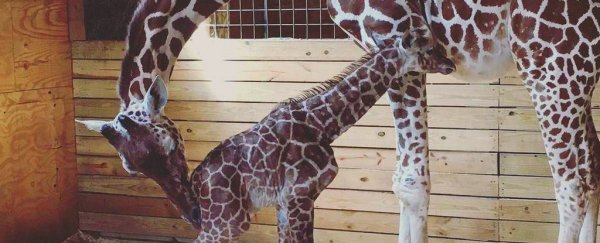Now before you stop and ask yourself why you're reading a story about a giraffe — one who may be pregnant but hasn't even been confirmed to be — you need to travel back to the winter of 2017.
April, the giraffe in question, was then an unknown giraffe, maybe even a little-down-on-her-luck giraffe, having ended up at a roadside zoo in Harpursville, a hamlet of 3,500 in New York's rural Southern Tier, at the age of 15.
For the uninitiated, that's solidly approaching middle age in giraffe years, and for this report's purpose, we may guess that the animals share feelings similar to ours about the inexorable march of time, the feelings of futility that recognition sometimes evokes and the ultimate inevitability that awaits us all.
But the park's trainers had done April a favor by pairing her with another giraffe, Oliver — at 5 years old, practically jailbait and, ahem, likely inexperienced, to say the least.
In the wild, the young lad would have been lucky to have had a female giraffe even so much as glance at him. But here they were, two lonely giraffes together at the Animal Adventure Park in this out-of-the-way corner of the earth, and, well, you might be able to surmise what happened next.
April became pregnant with the calf who would be her fourth, and it is safe to say that nothing was ever quite the same for her again. After her owners decided to live-stream her pregnancy, April became an Internet phenomenon, a YouTube starlet, the latest digital unknown to leap to worldwide fame without ever leaving the bedroom.
There were detractors, of course. But her fame only grew after the feed was briefly taken down in February 2017 by YouTube after some people, suspected to be animal rights activists, complained that it displayed nudity and sexual content.
They couldn't stop the sensation that was April. Millions of people tuned in from around the world to watch her as she paced around her pen, eagerly awaiting the calf's birth, weathering frustration, boredom, ennui and eventually countless conspiracy theories as she blew past due dates in January, February and March.
The BBC, no stranger to the intricacies of the gestation periods of royalty, called it the "most anticipated birth" since Prince George was born to William and Kate.
At its peak, April's live stream drew more than 5 million views a day. And the attention raised hopes that her fame could translate into a financial boost in Harpursville, a once-thriving manufacturing sector that had bumped up against the harsh realities of the globalized economy in recent years.
Nearby hotels booked packages that included admission to the animal park; signs were installed along the highway by a local business development group.
At the very least, the park was making money off her fame, hawking merchandise and selling the branding rights to her stream to Toys "R" Us, which evidently didn't get enough of a boost to keep it from going out of business.
Finally, in her namesake month last year, the giraffe gave birth to Tajiri, now more than 10 feet high at just over a year old.
And this week, April's trainers said she might be pregnant again.
It must be said that the act of conceiving is a typically sacred time, and one should give a couple space, to avoid prying and speculating — or worse, rumor mongering — and to wait patiently for the good news.
But April lives in public now, to paraphrase the 2009 documentary about early Internet live streaming, and everything is, perhaps, on the table.
It's certainly online, in the form of Animal Adventure Park's Giraffe Cam:
Jordan Patch, the owner of the animal park, said in a video published on Facebook this week, that another zoo was helping them complete tests to determine whether April was pregnant again.
"We have some exciting news," he said.
It was not exactly clear what the news was.
"We've done a lot of watching, a lot of looking, and we all have our opinions," another zoo employee said in the video. But she noted that they were not 100 percent sure the giraffe was pregnant.
In a previous era, perhaps the story of an unconfirmed pregnancy of a giraffe, fair as she is, at a small zoo in, respectfully, the middle of nowhere, would have hardly made a splash. Perhaps the editors at places like Fox News, USA Today and The Washington Post would have cast their weary eyes at the subject matter and said firmly, "Next."
Perhaps you would have moved on, too, saved a click, opened a book, gone outside.
But this is not an era like the ones before it. The live stream continues. The Facebook video got 910,000 views. And here we are.
2018 © The Washington Post
This article was originally published by The Washington Post.
